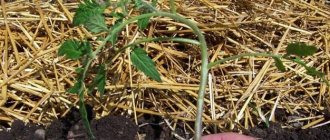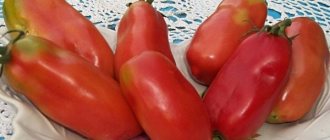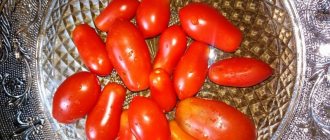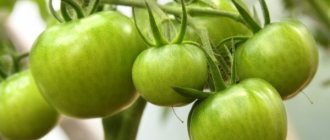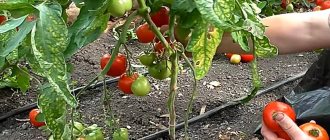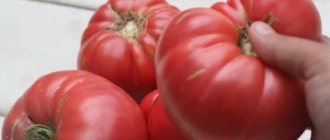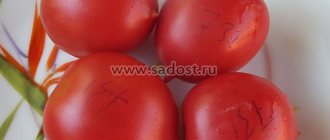Italian tomatoes are an indispensable part of tomato magic. The properties have been brought to perfection - taste, productivity, endurance. In the traditions of Italian national cuisine, delicious dishes are made from the fruits.
| Height | Landing location | Ripening time | Fruit color | Fruit size | Origin | Fruit shape |
| Tall | Greenhouse, Open ground | Mid-season | Reds | Average | Variety | Plum-shaped or oval |
Tomato Italian spaghetti in Russian gardens
Tomatoes Italian spaghetti can be safely classified as an exotic variety, not only because of its interesting name. By the way, Spaghetti tomatoes have nothing to do with Italian varieties of tomatoes, because they were bred by American breeders. The name of their successful brainchild was invented as a hint at the visual similarity of the fruit to popular Italian pasta. However, tomatoes are not very long and thin, but just oblong. They make excellent sauces that go well with spaghetti. So the name is multifaceted.
Healing qualities
Tomatoes are 95% water. Lycopene contained in fruits gives them a red color.
Fresh tomatoes are a source of minerals: iron, zinc, calcium, potassium, magnesium, phosphorus, the combination of which with vitamins B and C gives the human body health and vigor. The serotonin (happiness hormone) contained in them lifts your mood. They have antibacterial and anti-inflammatory properties. Lycopene is a natural antioxidant that helps reduce the risk of developing cardiovascular diseases.
Growing tomatoes. The illustration for the article is used under the standard license ©ofazende.ru
The jelly-like substance surrounding tomato seeds contains a substance called P3, which acts as a blood thinner and prevents blood clots. Due to the content of pectin substances, they reduce blood cholesterol levels and normalize blood pressure.
Oxalic acid, entering the human body, increases the alkalinity of the blood, due to which salts and toxins, uric acid, are removed from the body.
The fruits have a positive effect on the functioning of the kidneys, bladder, gonads, and increase potency. Eating tomatoes with herbs cleanses the liver and reduces the risk of malignant tumors. They are also used in medical nutrition for weakened patients and children, pregnant women, as well as for vitamin deficiency.
Tomato-based products used in cosmetology improve complexion, tighten pores, whiten skin, smooth out wrinkles and rejuvenate the dermis of the face
After heat treatment, they retain all their beneficial properties. To improve your health, it is useful to eat fresh red varieties of tomatoes and prepare dishes with rosemary and sage from them. By adding basil, dill and cinnamon to the dish, the wise housewife will receive an extraordinary “money” dish.
Related article:
Tomato cheat sheet
They have long been called love apples. Season fresh tomatoes with rosemary and feed them to your loved ones. By adding black pepper, bay leaf, dill or rosemary to tomatoes, you will prepare a dish that has special protective energy.
People who have food allergies to red foods, kidney disease, kidney stones or gallstones should consult their doctor about consuming tomatoes.
General information
Italian spaghetti tomato bushes grow up to two meters by the end of the season. Of course, such tall stems must be tied to supports.
The leaves are quite unusual. They have a dark green color and a wrinkled surface. The thickness of the stems is average, and they themselves are slightly pubescent. Spaghetti tomatoes bloom with simple yellow flowers. Each plant produces up to six complex-shaped racemes, with four to eight ovaries appearing on each of them.
Ask and receive useful advice from professional gardeners and experienced summer residents.>>
The fruits have a strange shape for tomatoes. They are too elongated, in appearance they resemble a pointed cigar with a length of eight to ten centimeters - look at the photo. Individual fruits sometimes grow up to fifteen centimeters in length. Italian tomatoes weigh from 100 to 150 fifty grams.
The skin of the fruit has a glossy surface and is quite thick. At the ripening stage, these tomatoes have a light green color, and a dark green spot is clearly visible near the stalk. Ripe fruits acquire a crimson color, and the stain disappears.
The flesh is firm, but quite juicy. It contains very few seeds, which makes the seed chambers half empty.
As for the taste, one cannot call it too expressive, but this variety is delicious.
Features of the variety
These tomatoes have an average ripening period and fairly high yield. According to reviews, vegetable growers harvest up to five kg of fruits from one square meter of plot. Maximum yield can be obtained only with greenhouse cultivation.
The process of fruit ripening is extended in time until the end of September, this is undoubtedly an advantage of the variety. It is important that the yield of Italian spaghetti is little affected by the degree of illumination in the greenhouse.
The plant, according to its characteristics, has powerful immunity to diseases traditional for nightshades. At the same time, gardeners claim that sometimes tomatoes are affected by late blight.
Italian spaghetti is stored for a long time without forced cooling, while retaining its taste. Unripe tomatoes ripen well indoors.
As for use, the variety is universal. Tomatoes are good in salads and convenient for canning. They can be packed tightly even into narrow jars. The fruits are frozen, dried, dried.
Characteristics
- The variety is classified as mid-early;
- The yield is good, up to 5 kg of fruit can be collected from 1 square meter. Maximum indicators are observed in closed ground;
- fruiting is extended, harvesting ends at the end of September;
- in terms of lighting it is undemanding, bears fruit even with insufficient light, which makes it suitable for greenhouses;
- immunity is excellent, but, according to some reviews, it can be affected by late blight;
- transportability is good, tomatoes can be stored for a long time without loss of commercial quality;
Read also: 10 best grape varieties
- in use Italian spaghetti is universal. Good for salads. The small size of the fruits is convenient to preserve; they fit tightly in a jar, and many housewives consider this variety ideal for canning. Tomatoes can also be pickled, dried and frozen, after cutting them into slices;
- The harvest that has not had time to ripen ripens perfectly.
Growing
It is better to grow Italian spaghetti tomatoes using seedlings. Seeds for seedlings should be sown two months before planting in open ground or in a greenhouse. The variety does not require any special conditions for growing seedlings. Many gardeners will assure you that seedlings of this variety do not need to be hardened off before planting. But still, hardening never hurts.
No more than three bushes are planted on one square meter; only two stems are left on each of them, which are tied to reliable supports.
It is important that the variety is unpretentious to the condition of the soil in terms of its density. Of course, it must be fertile, without weeds.
Spaghetti tomatoes should be watered only as needed, when the soil underneath dries to a depth of two centimeters. Watering is not done often, but abundantly.
During the season, these tomatoes should be fed three or four times with complex mineral fertilizers at regular intervals.
Tomato Prince Borghese: description of the Italian variety
The Prince Borghese tomato was created in the last century by Italian breeders and is recommended for cultivation in greenhouse conditions or in film greenhouses, but can also be successfully grown in garden beds in open ground.
This tomato belongs to the indeterminate type, its bushes are distinguished by their high growth - up to 1.5-2.0 m and even higher
. The shoots are powerful and strong, well leafy. Their foliage is typically tomato-like, narrow, elongated, with sharp tips, and a rich emerald color.
Important!
Prince Borghese tomato bushes require the formation of 2-3 stems. Also, tall shoots require tying to strong supports and regular pinching.
The Prince Borghese tomato is classified as an early or mid-ripening variety - about 105-130 days pass from the moment the seeds germinate until the first ripe tomatoes are harvested.
Tomato Prince Borgise: detailed description of the variety
Manufacturer Aelita offers an early variety of tomato, Prince Borghese, which ripens in 105 days. And Russian Garden describes its variety as mid-season and gives a ripening period of 120-130 days.
The first racemose inflorescence is formed under 6-7 permanent leaves, and each subsequent one - after two leaves. Each cluster can hold up to 15 tomatoes.
Interesting!
Prince Borghese is a very productive cherry variety. During the season, up to 450-500 cherry fruits ripen on each bush of this variety.
Ripe fruits are oval, with a small nose at the tips. At the stage of full ripening, the color of the dense, smooth skin is rich red; ripe fruits have no dark spot at the base. The fruit weight of the Prince Borghese tomato is approximately 20-35 g.
Ripe tomatoes are not prone to cracking, but ripening tomatoes must be picked immediately so that other fruits begin to ripen.
The fruits of the Prince Borghese tomato have an excellent presentation: beautiful, even, compact, dense.
The pulp is tender, quite dense, each fruit has 3 seed chambers with an average number of seeds.
Excellent varieties of tomatoes:
Jack Pot F1 Liqueur F1
The harvested crop can be transported over any distance, and ripe fruits can be stored under appropriate conditions for up to two weeks.
Be truthful about the shortcomings
Tomatoes Italian spaghetti has not yet gained high popularity in our country. There aren't many reviews about them online. However, what can be said for sure is that this variety is ideally suited for growing organic vegetables, as it does not require chemical protection.
Gardeners complain that the appearance of these tomatoes does not match their description. This is not a mass phenomenon, but it happens that the fruits are very large and such tomatoes are difficult to fit into jars.
This is perhaps the only drawback. Again, you can eat them raw or master the drying process – yummy!
Main characteristics of the variety
The Prince Borghese cherry tomato is distinguished by its high yield, excellent taste of the harvested fruits and versatility of use. It should also be noted that even with temperature changes, the bushes of this variety set fruit well.
Productivity
In greenhouse conditions, the Prince Borghese tomato is distinguished by good fruiting - up to 10-12 kg of ripe cherry tomatoes are harvested from each square of area.
Area of application of fruits
The harvested crop is distinguished by its versatility of use - tomatoes are used for food, added to salads or snacks, and also to decorate dishes.
Plus, these cherry tomatoes look great pickled in jars
– they do not burst during heat treatment. And their taste does not deteriorate. Also, ripe tomatoes of this variety can be dried with the addition of olive oil and dried.
Diseases and pests
The Prince Borghese tomato is highly resistant to most diseases characteristic of other types of tomatoes.
The main advantages of the variety
The main advantages of the Prince Borghese tomato variety include:
- high resistance to major diseases affecting tomatoes;
- uniform ripening of the crop;
- versatility of fruit use;
- the ability to collect your own seeds for further planting;
- good tomato taste;
- ripe fruits tolerate transportation well;
- The harvested crop can be stored for quite a long time in appropriate conditions.
No particular shortcomings were identified in this tomato.
Characteristics and description of the Italian sweet tomato
The place where the tomato will be grown, the composition of the soil, your preferences (small, large fruits, tall or low bushes) play a big role in the choice of planting material. To do this, be sure to familiarize yourself with the characteristics of the variety.
- indeterminate;
- tall;
- mid-season;
- yield - up to 5 kg per bush;
- large-fruited;
- cultivation - greenhouse (middle zone);
- height – up to 2m;
- feature – medium leafy;
- stem formation – 1-2.
- shape – flat-round, with slight ribbing at the stalk;
- size – large;
- weight – 300-500g;
- color – raspberry;
- taste – sweet;
- pulp – fleshy;
- Use – fresh consumption, in juices, sauces, lecho.
Tomato Prince Borghese: reviews from those who planted
Anna, 55 years old, Novosibirsk region. Prince Borghese is perfect for growing in Siberia in a greenhouse. I have four grandchildren, so we eat most of the harvest fresh; the children really like cherry tomatoes. They also salt well and retain their shape well.
Elena, 46 years old, Belgorod region I have been growing Prince Borghese tomatoes for several seasons now. I can say that the bushes of this variety grow tall, so you have to tie the shoots to strong supports and form the bushes into no more than 3 shoots. But a lot of clusters are formed on the bushes, and each one produces more than 10 fruits. As a result, I reaped a large harvest, enough for both food and twists.
Yellow tomatoes: A selection of the best varieties with descriptions and photos
Valeria, 50 years old, Moscow region The Prince Borghese tomato has a very decorative appearance when the tomatoes begin to ripen on it - everything is literally strewn with red tomatoes. Fruit ripening takes place throughout the season, and unripe fruits are perfectly ripened at home. The fruits are tasty and sweetish, but at the tops of the shoots they are too small. It’s simply an excellent variety for preservation.
Olesya, 60 years old, Samara region I have been growing Prince Borghese tomatoes in my greenhouse for the third season in a row. The bushes grow very tall; I had several tomatoes of this variety over 2 meters high. Productivity is excellent, taste is good. They say that these tomatoes are excellent sun-dried, but I have never made them, so far I have only marinated them.
Tomato Prince Borghese - one of the best varieties of cherry tomatoes
. Each bush, with proper care, produces up to 500 ripe fruits per season, which will delight vegetable growers with their beautiful appearance and pleasant taste.
Benefits of Italian Sugar Tomato
Benefits of Italian Sugar Tomato
Their characteristic features of the variety and growing conditions follow:
- high growth allows efficient use of greenhouse space;
- less green mass compared to other varieties;
- possibility of forming two stems;
- yield up to 5 kg per bush;
- large, sweet, fleshy fruits;
- delicious juices, sauces, lecho;
- average ripening time;
- long fruiting.
Reviews
The Italian sweet tomato lives up to its name: sweet, tasty, fleshy fruit. The tomatoes are large in size. I grew it in a greenhouse: the bushes are tall - about two meters, the yield suited me, it formed three stems. Result: I liked the variety.
I was initially attracted to the Italian sweet by the name, so I decided to check whether the tomato was actually sweet. They write that it is sweet, but is it really so? The result was pleasing: the tomatoes were sweet, meaty, and large. I grew it, as recommended, in a greenhouse. True, I didn’t plant many bushes - only five, but I had enough for a test sowing. I’ll plant more today – I love fleshy and sweet tomatoes. I recommend this variety. Of course, its whole form is not suitable for pickling, but you can cut it if you really want to pickle it. We plant not only for food, but also to enjoy what we like in the summer.
Description and characteristics of the variety
Tomato Italian nuts is a determinate, low-growing variety. It is characterized by:
- shoot height does not exceed 50 cm;
- compact bushes;
- stems are thick, stable;
- There are 8-10 fruits on fruiting clusters.
- average weight 80-100 g;
- neat, uniform sizes;
- strong skin;
- the pulp is sugary, dense;
- the taste is sweet.
Tomato Italian nuts. Super early. Bush 40 cm. Red, round, 100-120 g, the fruits will be the first to reach your table. Champion of ripening, bears fruit even in the shade, very tasty, and there are so many fruits that we didn’t have time to pick them, the bush is beautiful.
Video review of varieties:
Youth
Visibly-invisibly
Pickling delicacy
Stone Flower
Italian nuts
The “Italian” variety is a rare and unusual variety for Russia. In all regions, these tomatoes develop well in greenhouse conditions. The fruits are ideal for pickling and making sun-dried tomatoes.
They have a dense consistency and durable skin, which makes them well stored.
Italy/Foggia (part 2. Syngenta research center/tomato fields)
Let me return to my story about Italy.
Sunrise from my room at the Hotel Lloyds Baia di Vietri sul Mare
I had never had the opportunity to visit a production site, and it was in Italy that such an opportunity opened up for me, and I immediately agreed without hesitation. After all, it is always very interesting to find out after what complex and simple manipulations this or that product ends up on the store counter. I really wanted to plunge into this “cuisine”. And now I'll dip you into it. What can you not imagine, say, pizza without? What about lasagna?
I think most people thought correctly about tomatoes. Of course, there are those who do not like them or who are allergic to tomatoes, but undoubtedly there are more lovers of this vegetable. After all, so many delicious things can be prepared with their help. So I can’t imagine my life without tomatoes. I love them fresh with salt, in salads and as a sauce in pizza, lasagna, pasta, and risotto. In winter we make do with imported cherry tomatoes, since winter artificial/greenhouse ones are akin to polystyrene foam. And of course, canned tomatoes; what Russian table would be complete without this snack? In my first post about Italy, I already touched on the topic of tomatoes. So we will talk about pelati tomatoes. Pelati tomatoes (skinless tomatoes), obtained from elongated tomato varieties, have been produced for over a century on the Mediterranean coast of Italy, in the Campania region, and especially in the provinces of Naples and Salerno, and are of exceptional quality. These pelati are especially good for making sauce, as they do not lose their taste even at high temperatures. But more on that later. In this case we will talk about the organization ANICAV
(National Association of Canned Fruit and Vegetable Manufacturers), which was created on February 5, 1945 in Naples and is considered one of the most important associations for the industrial production of tomatoes. It consists of 110 enterprises, most of which are located in central and southern Italy.
What’s interesting is that I have never seen or imagined industrial harvesting of tomatoes. In the province of Foggia at the Syngenta
, the assembly of tomatoes is carried out using machines with a built-in photocell, which select tomatoes by color and exclude green, damaged, rotten fruits, as well as fruits that have any other effect. You can be sure that what ends up on the table is not a pig in a poke, but carefully selected, ideal tomatoes in a jar.
80% of the tomatoes are harvested this way, and the remaining 20% are picked by hand. Tomatoes are collected manually, as there are certain varieties of tomatoes whose ripening time is regulated by specific quality brands (for example, San Marzano), for which mechanical assembly could lead to serious damage to the product.
As you can see, growing tomatoes here and in Italy is significantly different. Remembering my childhood spent with my grandmother at the dacha, I can say with confidence that our tomatoes grow in thick tops, but here the tomatoes are spread out like a carpet on a field. There are few tops and the tomatoes can hardly hide in the shade of the leaves from the bright rays of the sun. And those who did not hide get burned.
Most of Syngenta's
occupy the fields. The center’s employees come to different conclusions every day through experience. They work to show the world what opportunities vegetables have, to constantly improve the quality of the product, and monitor the impact of agriculture on nature. About 5 thousand people are involved in these studies. In addition to tomatoes, other vegetables and fruits are grown here, for example, zucchini, watermelons, melons, peppers, flowers, etc. People here work not for the sake of quantity and further sale, but for the sake of quality, they find out under what conditions plants begin to get sick, how they can be treated and infection can be prevented. How plants and fruits react to certain conditions, the time of fruit ripening.
At the center we were treated to seedless peppers, which were bred here and look like hot peppers or elongated tomatoes. Such a funny little pepper.

